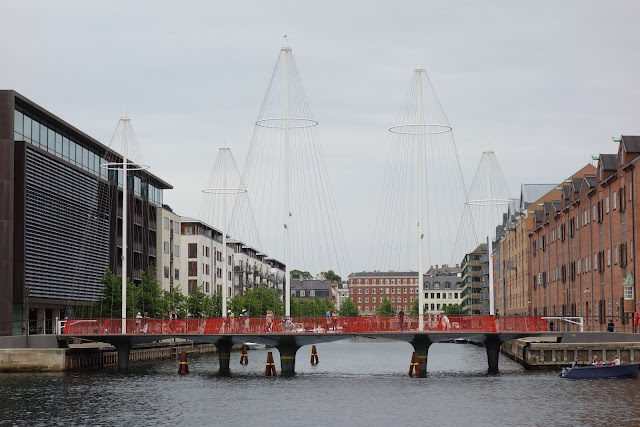
By Mia Riefkohl / Copenhagenize Design Company
The City of Copenhagen minds the gaps. Over the past decade, we have witnessed radical changes in the connectivity of Copenhagen, a city bisected by a harbour. We’ve watched as thirteen bridges have popped up (with four more on their way), connecting previously cut off neighbourhoods while facilitating a 13 km recreational path, the Harbour Circle. Mobility and bicycle user experience are both high priorities on the City’s agenda, and these bridges are only a part of a greater plan. But most notable of all, each and every one of these new bridges are off-limits to automobiles, saying loud and clear that this is a city for people. A Life-Sized City. To show how serious the city takes connectivity, we created a map showcasing the new and upcoming bicycle bridges of Copenhagen.The map above is divided into three categories: the built, the temporary and the proposed. The ten already built are currently in use by those looking for a fast A to B. Bridges are the mobility link inside the urban toolbox that effortlessly solves the problem of crossing an obstacle. Done properly, a bridge is A-to-Bism at it’s finest. The significant number of bridges is immediately noticeable on our map. While thirteen new bridges for bicycle users and pedestrians have opened since 2006, nine of of them were built in the last two years alone.
Overcoming the Harbour and Canals
Completed in 2006, Bryggebroen was the first new connection built over the Copenhagen harbour in centuries. Bryggebroen served to connect Havneholmen to Islands Brygge and beyond, giving Copenhageners a much needed connection over the harbour. However, crossing the bridge into the city, riders were forced to choose between two inconvenient options: to push their bicycle up steep stairs, or take an inconvenient, indirect, detour weaving through pedestrians. This gap was filled with the addition of the Cykelslangen, (The Bicycle Snake), in 2014. Cykelslangen is an elevated, orange bike lane, elegantly connecting Bryggebroen to the neighbouring districts, along a dedicated, bicycle only pathway. Shortly after opening, Cykelslangen became an instant Copenhagen urban icon for it’s practical, elegant and functional Danish design. At last count, the two bridges accommodated 14,200 and 12,700 daily bicycle riders, respectively, far exceeding traffic flow predictions. These two bridges set a new standard, bicycle bridges are not only widely popular among residents and visitors alike, but an incredible investment.

Bryggebroen (upper) and Cykelslangen (lower) connecting neighbourhoods. Photo: Ole Malling.

The new Inderhavnsbro connects the city centre with Holmen and beyond.

Trangravsbroen conveniently connects three corners of the Holmen district.
Shorter bridges over 17th Century canals, such as Cirkelbroen (the Circle Bridge), and the Frederiksholm Canal bridge, help link almost the entire harbour. Designed by the Danish-Icelandic artist, Olafur Eliasson, Cirkelbroen opened in 2015 and fixed a minor, but important gap in the mobility network of Copenhagen. This beautiful, but modest bridge connects Christiansbro with Applebys Plads and accommodates 2,200 bicycle users daily. Even smaller bridges, less decorated bridges, like Dyssegravenbroen and Laboratoriegravenbroen bridge in Christiania and the Lersoparken-Ryparken bridge also have a big, positive impact on A-to-Bism. The Dyssegraven and Laboratoriegraven bridges are new connections from eastern Amager into the city. While we were biking through Dyssegraven, we stopped and asked a local for his thoughts on the bridge: “It is part of something big. Copenhagen does a lot for cyclists and pedestrians to get around.” We couldn’t agree more.
Olafur Eliasson's Cirkelbroen, inspired by a harbour full of sail boats.

Laboratoriegravbroen in Christiania.
Bridging Urban Divides
It’s easy to see the need for bridges in a maritime city like Copenhagen, but the City’s efforts to connect the urban fabric doesn’t end at the harbour’s edge. Bridges and tunnels also connect bicycle riders to areas previously cut off by busy roads, railways, and construction sites.The bridge between Lersoparken and Ryparken was completed in 2014, allowing for pedestrians and bicycle users to cross between two parks and neighborhoods while avoiding indirect and busy roads. Åbuen, opened in 2008, eliminated the challenge for bicycle users approaching and exiting the road bordering between Nørrebro and Frederiksberg. Folehaven Bridge will connect and ensure a safe passage between the Vigerslev park and the Folehave area over the rest of Valby. This bridge will help bicycle users avoid the major traffic barrier that is. The bridge will be located at the municipal boundary and with it’s design it will serve as a dramatic welcome to the city of Copenhagen, reminding automobiles that bicycles are above them.

Åbuen, crossing over Ågade
 The newly opened Østerbro tunnel
The newly opened Østerbro tunnelBridges on the Horizon
The four proposed new bridges will all further develop the accessibility of the central part of the city and the harbour. Langebrogadebro will connect Vester Voldgade and Langebrogade in Amager and is expected to be completed in 2018 as part of Realdania’s Blox development. The bridge will become part of the green wave network or ‘Grøn Bølge’ that will relieve both car and bicycle congestion of Langebro and Knippelsbro.

As part of Realdania's BLOX development, the foundation has announced Langebrogadebroen, a new pedestrian and bicycle bridge over the harbour.
And perhaps most fantastical of all, there’s the Nordhavn Tower Bridge incorporated into the Copenhagen Gate tower development. Taking the elevation into account, the bridge is hardly an A to B solution. Though initially meant to serve pedestrians and bicycle riders, the latest plans suggest the bicyclists will not be admitted onto the bridge. The bridge will lead from one tower to the other, one at Marmormolbyen and the other upon Langelinie. Each tower will carry its own cable-stay bridge between the two piers and due to the site geography, these bridges will meet at an angle. And we thought the kissing bridge idea was crazy…

The proposed Copenhagen Gate






